Tank the tortoise was on a mission to destroy.
Within minutes of meeting me, the beer keg–sized animal tried to tear down a banner for American Tortoise Rescue, the ranch in Malibu, California where he lives, and shoved a giant garbage can 6 feet across his pen. Then he headed back to his pile of carrots for a restorative snack.
With their animatronic, pigeon-toed walks and dinosaur snouts, sulcata tortoises — also known as African spurred tortoises — have a dedicated fanbase and are surprisingly popular pets. Leonardo DiCaprio has one; so does 49ers quarterback Colin Kaepernick.
To understand why, you just have to look at a baby sulcata. It’s tough to overstate how cute they are. They fit right in the palm of your hand, their pinkie nail–sized heads swiveling around on a constant search for food. When you approach a tank full of babies, they bumble over on toothpick claws to crowd around your hand, eager for a bite of lettuce or a fruit treat.
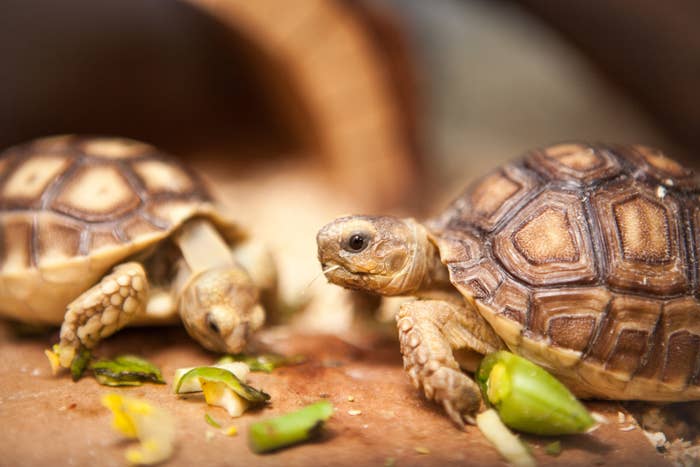
Wherever you live in the United States, and whatever the climate, you can buy your very own sulcata in a pet store for between $50 and $200. Stick it in a fish tank with a UV light and some lettuce, and you’re good to go. According to the 9,250-person-strong Facebook group Sulcata Tortoises, the animals are “no trouble at all.”
But they don’t stay small for long. Properly cared for, males can grow to over 200 pounds, females around half that. Like “teacup” pig buyers, prospective sulcata owners are often burdened with significant misinformation. Pet stores sometimes tell customers that the animals stay small if kept in a small tank (they don’t), that they can eat anything vegetarian (they can’t), and that if they get too big, a zoo will take them (a myth that zookeepers are sick of debunking). Even kept with the best intentions, sulcatas might develop deformed shells, or tear up drywall and backyards.
“They’re just pretty destructive. Any place you see a wall, there’s some reason with a sulcata,” Susan Tellem, American Tortoise Rescue’s co-founder, explained as she showed me a deep hole Tank had dug recently. Even sliding doors can be a problem: Tellem had to put up a wall between Tank and the house when he figured out how to slide the glass and screen doors open with his legs to get inside.
Which is not to say that the sweet and friendly animals never make good pets. Tellem calls them “hard dogs,” and Tank comes when he’s called. “They’re personable, they’re entertaining, they know their names,” Tellem said. “People don’t realize how smart they are.”

But you’re bound to run into problems when you combine breeders who produce thousands of cartoonishly cute hatchlings a year; buyers who get the third-largest tortoise species on a whim without educating themselves; pet stores that sell the animals without warning buyers how big they’ll get or how to care for them; and wonderful, knowledgeable owners who nevertheless age out of being able to care for a heavy and long-lived pet. Sulcatas are nearly guaranteed to outlive their owners. Experts aren’t sure exactly how long they live in captivity, since the pet trade started only around half their lifespans ago, but educated guesses peg it at over 100 years.
All told, this adds up to hundreds or even thousands of tortoises across the country who need new homes — mostly males, who fight one another when kept together and aren’t particularly useful to breeders. And because adult sulcatas need so much space and can be difficult to adopt out, many reptile rescues can’t take them in anymore.
While some conservationists have been able to give unwanted pet sulcatas jobs — such as a project that uses them for natural weed control in a Hawaiian nature preserve — most abandoned tortoises are just looking for a place to call home. Do you have a walled yard, a strong back, and a desire to put a possibly centenarian tortoise in your last will and testament?
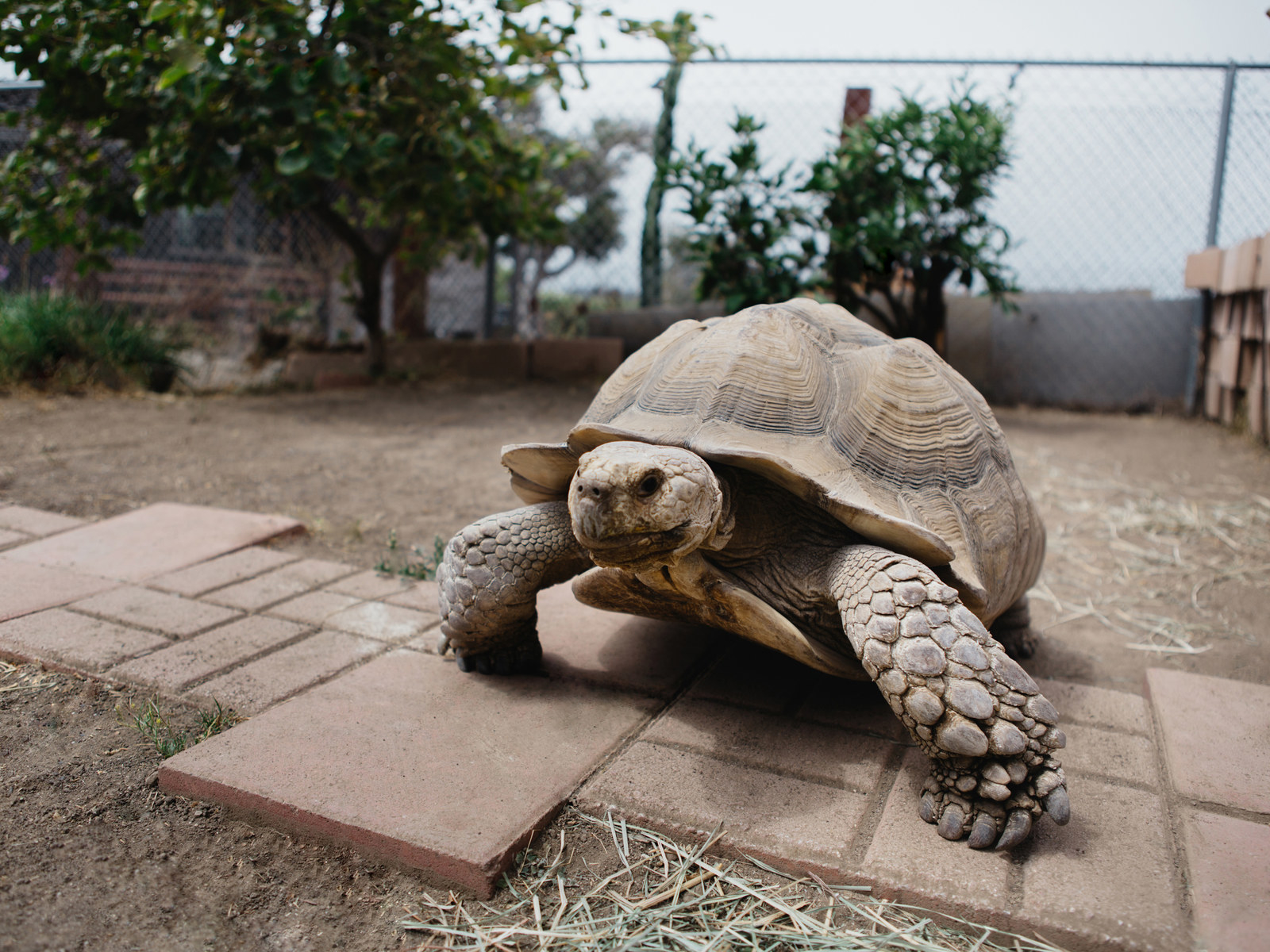
Paul Bulley has been breeding sulcatas for 15 years at his two Orange County homes, which together he calls “Tortuga Villa.” He met me in front of one of them in April, wearing gray camo shorts and a hat with a picture of a machine gun that read “Come and take it.” (The first time we chatted on the phone, he asked me if I was law enforcement.)
All kinds of tortoises live at Tortuga Villa — radiated tortoises, Indian star tortoises, and even Aldabras, a rare species that, in extreme cases, can tip the scales at 800 pounds and live over 200 years. But I was there to see the sulcatas; Bulley has around 20 of the typical brownish-gray ones grazing in a field and a couple of albinos in a smaller pen with burlap covering it for shade.
Bulley says he sells mostly baby sulcatas — up to a thousand in a good year, for $50 to $75 each — to pet stores, wholesalers, and private parties as a way to support his hobby. Between electricity and food, he spends about $2,500 a month keeping his 10 species of tortoises healthy and happy. Since sulcatas don’t hibernate like other tortoises, they also need access to a warm hidey-hole year-round. All that heat uses so much power that Bulley once got a visit from the police, who thought he was growing weed. “They came and visited me and were like, ‘Can we look at your tortoises?’”
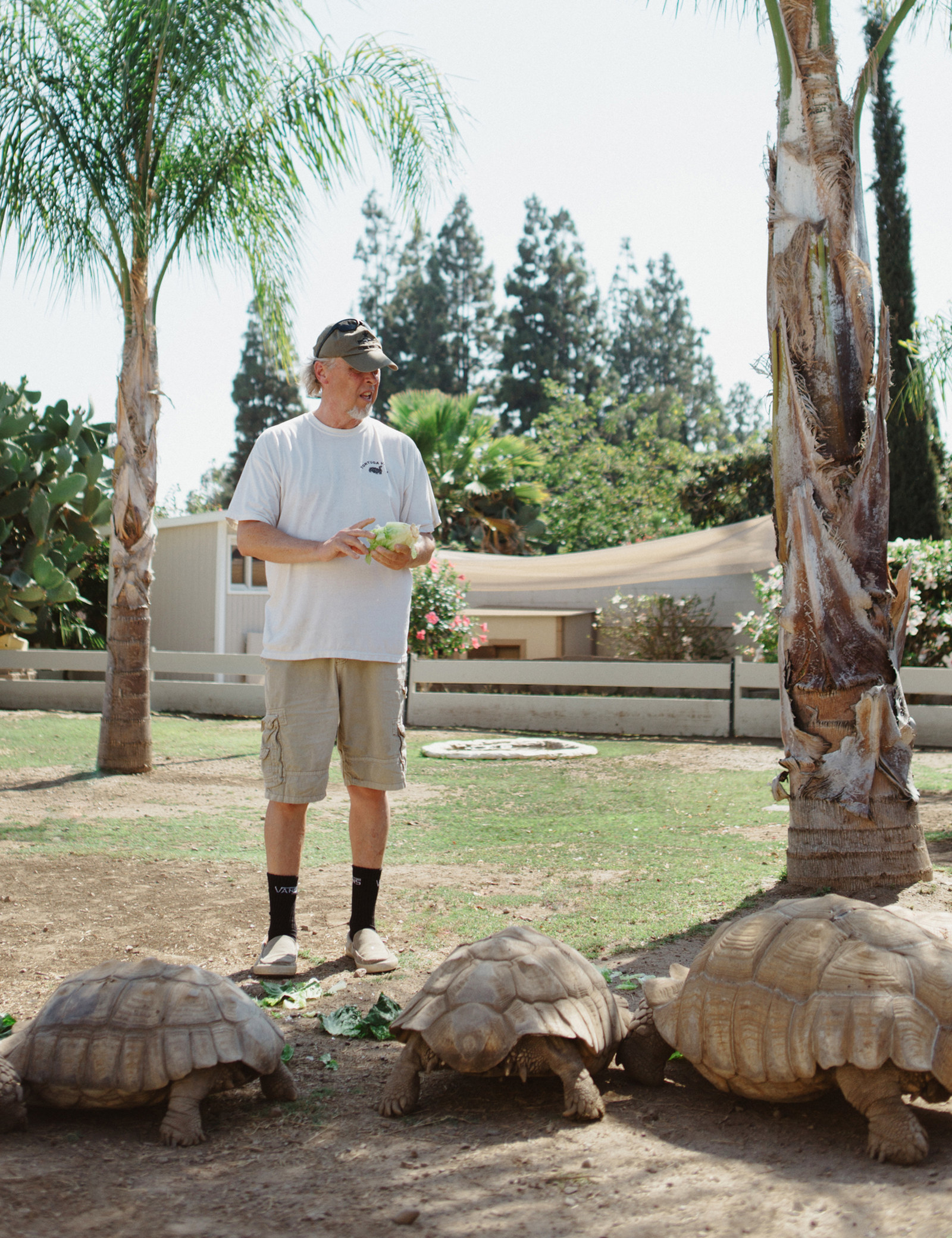
Bulley, like any tortoise enthusiast, doesn’t need a license to breed sulcatas, though permit regulations for ownership and sales vary from state to state. That makes pinning down how many live in the US next to impossible.
“Unfortunately I cannot begin to answer that accurately,” Abigail DeSesa, executive board chair of the California Turtle and Tortoise Club — a society for aficionados and rescuers — told me by email when I asked if she could estimate the sulcata population in the United States. “What I can clearly state without a single doubt is there are too many. There is a serious breeding problem in the United States.”
Sulcatas are believed to have first arrived in the US in the 1960s, when a few were imported from the southern edge of the Sahara by wealthy obsessives, including big-game hunter Paquita Machris, whose kills live on in dioramas at the Natural History Museum in Los Angeles. The first US babies were born in the 1970s, but they stayed a rarity until breeders figured out the best incubation strategies. By the early 2000s, an “exponential cascade” of the animals had flooded the US pet trade.
Sulcatas are prodigious egg layers — several times a year, between 15 and 50 in a clutch — so breeders can produce thousands of babies with relatively little effort. Over the years, overbreeding has pushed the prices of the tiny tortoises down to a fraction of their cost when breeding first took off. A $70 tortoise is a much more palatable impulse buy than one with a steeper up-front cost — but impulse buys that become inconvenient are easily discarded.
Many sulcatas get dumped in garages or basements, far from the sunlight they need to synthesize vitamin D and keep their shells and bones healthy. Without it — or with too much or too little protein, or too little humidity, or too little calcium — sulcatas will develop metabolic bone disease, a catchall term for skeletal disorders resulting from malnutrition. A healthy sulcata’s shell is smooth and round, but many of those raised in captivity suffer from some degree of “pyramiding,” a bone disease where they develop characteristic spikes on their carapace, the top half of the shell.
Bulley said he thoroughly vets prospective owners he doesn’t know — asking them where they will keep the babies, how they will care for the resulting adults, what kind of diet and setup they’ll provide. To keep the tortoises comfortable and prevent them from digging under house foundations, most experts, including Bulley, recommend that owners build sheds or doghouses in the yard, heated to at least 80 degrees year-round. Bulley said he’s taken at least 100 male sulcatas off owners who were in over their heads, both from his own customers and from people who find him online. “A lot of my tortoises are rescues or adopted,” he told me. “People give me tortoises all the time.”
The real blame, Bulley insisted, lies with pet stores, which he said often mislead buyers. “They’re kinda in it for the money,” he said, though pet stores are among his biggest clients. “I don’t think they give people the right information.” When asked how he vets stores and wholesalers, Bulley said, “I only deal with people I know real well, and pet stores that have a good setup.”
Bulley acknowledged that many other tortoise rescuers would argue that he is also acting irresponsibly by breeding sulcatas in the first place. “They probably don’t like me,” he said. “But I don’t worry about what people think of me, ’cause I do a lot of good, too.” He created Tortuga Villa’s website not to sell babies — he sells plenty as it is — but to provide information for those looking to be better owners. Bulley doesn’t believe in shipping tortoises, so the site doesn’t list any prices or ordering information.
“Some people get irritated with me. They go, 'Do you want to sell one or not?'” he said. “And I go, 'Well, I would...but maybe I don’t feel good about you owning one.”
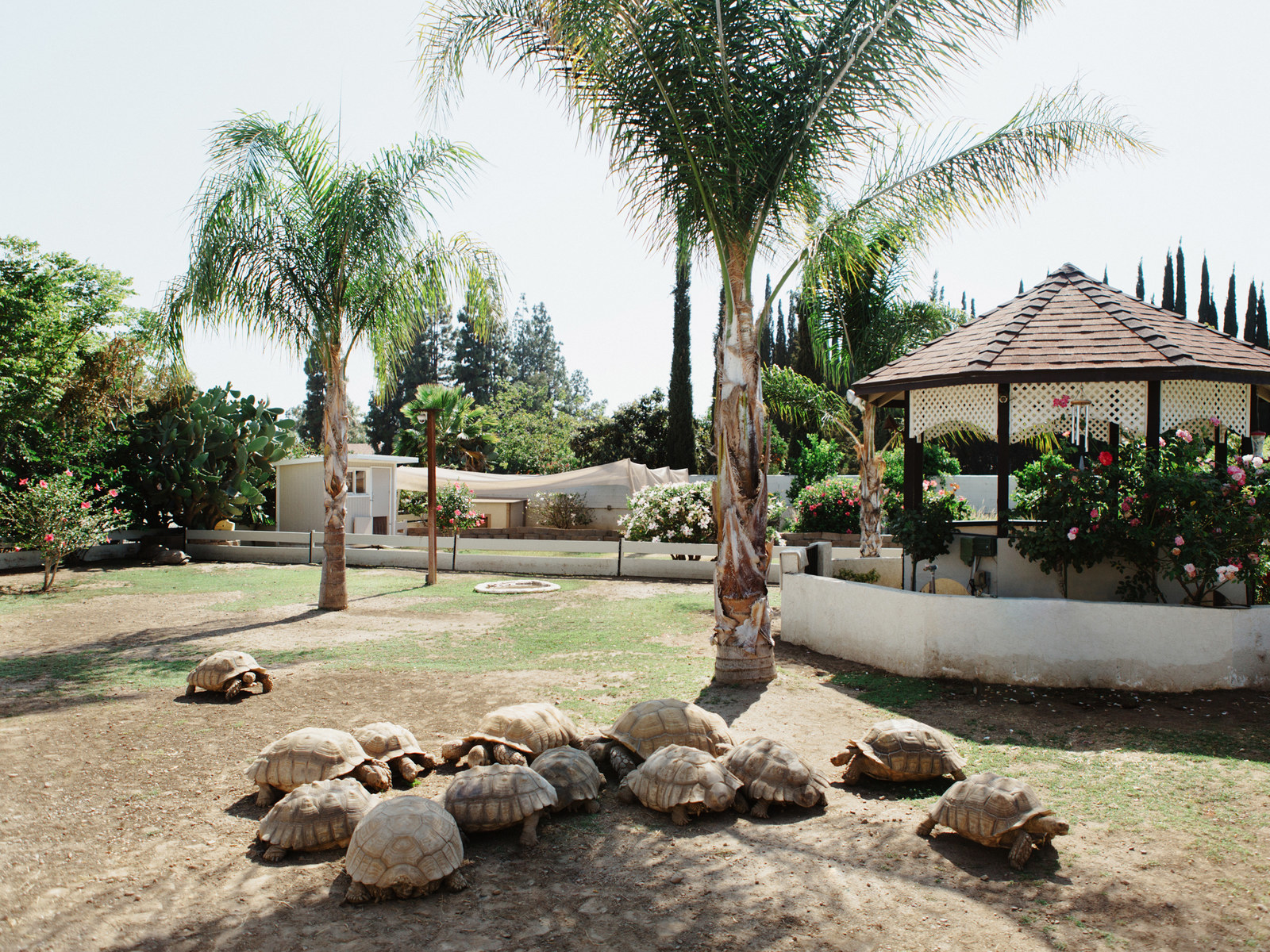
In spring and summer of this year, I went to four pet stores in Los Angeles County and the Bay Area that sell sulcatas. All were openly selling babies (except for one store that had just sold out), with the caveat that the little ones were for educational or research purposes only. There is a federal law stating that tortoises and turtles under 4 inches can’t be sold as pets, since tortoises, like all reptiles, can carry salmonella — and a tiny tortoise is just the right size for a toddler to pop into their mouth. I asked the salespeople a series of questions — what kind of food sulcatas eat, how big they get, how long they live — and heard nearly every myth Bulley and others I’d spoken to complained about, though not as often as I was expecting.
At one of the stores, the salesperson told me sulcatas will stay little if you keep them in a small tank their whole lives (a myth that haunts many tank-dwelling pets). While it is true that the tortoises should be kept in tanks as babies, within two years they’ll be less susceptible to harm and need room to roam. He also referred to the species as “the easiest tortoise” to care for, saying they will eat anything vegetarian. He neglected to mention that a diet of anything besides 85% grasses, weeds, and low-protein hay is likely to result in bone disease.
At the other stores, the salespeople were honest about how large sulcatas grow, though one of them also said the Oakland Zoo would take them when they got too big. “There’s just no way I can take in every animal people want to give up,” said Margaret Rousser, a zoological manager at the Oakland Zoo. “I have to make sure I have the resources for the animals that are already here on grounds.”
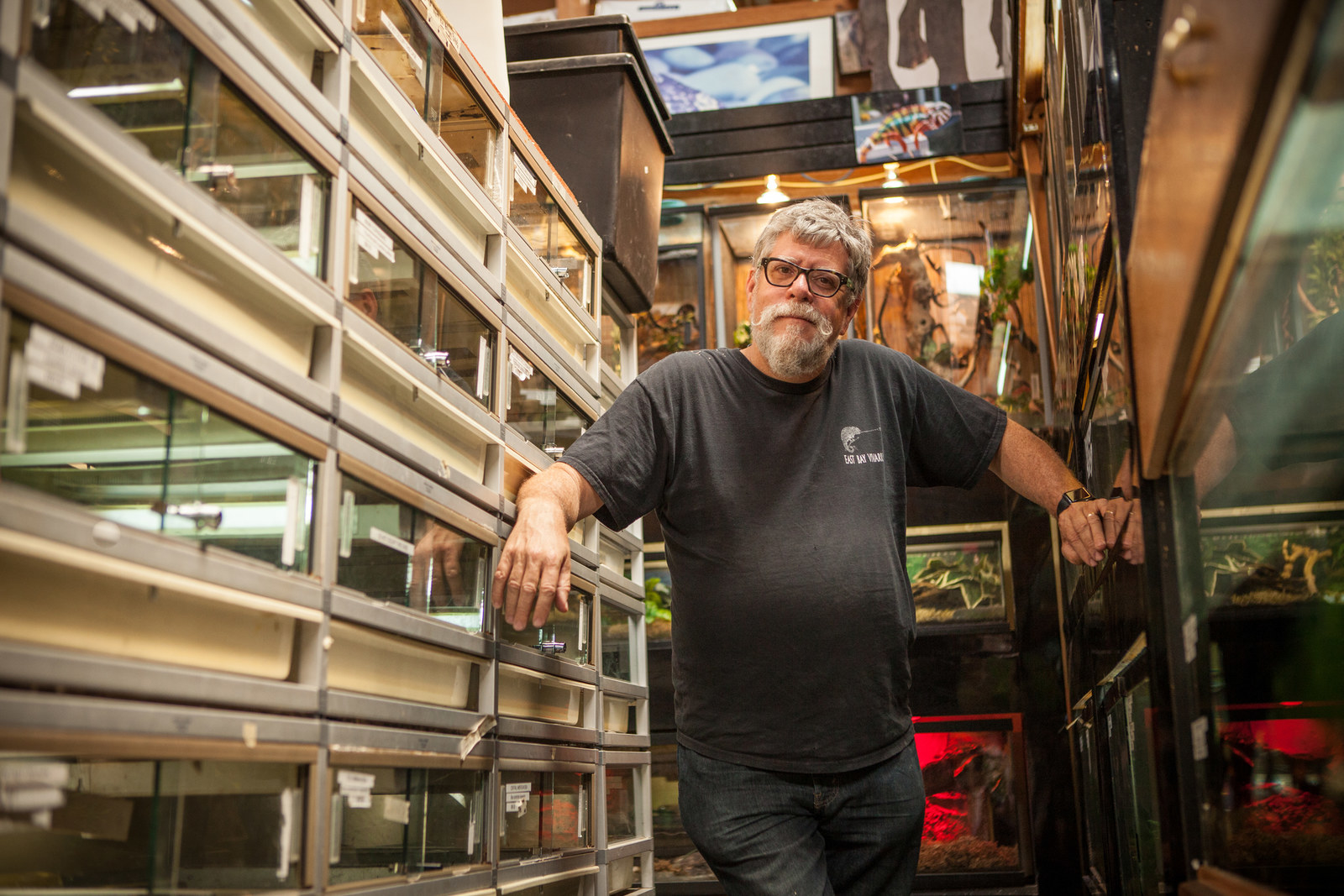
Owen Maercks, cult-famous musician and co-owner of the East Bay Vivarium in Berkeley, clearly cares deeply that his animals go to good homes. The store, which gets 20 to 30 baby sulcatas every two to three months, can sell them within a few months. But for every hundred people who come in and say “Look at the cute tortoises!” only one or so will actually take one home. That’s because when passersby stop to ogle the babies near the front of the store, Maercks and his employees direct them around the corner to Carl, an 8-year-old, 50-pound sulcata. “The first thing I say is, ‘This’” — Maercks pointed to the babies — "'plus eight years equals that'" — he pointed to Carl. "And that's still half-grown."
Maercks is one of several sulcata distributors I spoke to who insists that would-be owners take a hard look at their own mortality: When parents bring their children to look at sulcatas, he asks the kids whether they plan on having grandchildren who can take care of them.
Carl, who was sulking in the corner of his UV tank until a shop worker presented him with a bus bin full of food, is Maercks’s current “show tortoise,” a two- to three-year position for medium-sized sulcatas. The gig involves heading out with Maercks’s traveling reptile show, while spending downtime dissuading casual baby buyers.
“He’s half-grown,” Maercks told a little girl in a princess dress who was watching Carl stomp through his tray of veggies, which the Vivarium gets for free after their sell-by date from a local grocery. (Maercks recommends every owner of a large sulcata befriend a grocery store manager and indulge in “the time-honored tradition of dumpster diving.”) Carl dragged his dinner into the shavings and then started to eat with voracious lunges of his dinosaur beak. The little girl borrowed her dad’s cell phone to take pictures.
“Our store sells them conscientiously,” Maercks told me. “You’re not going to buy it and take it home and then two years later wonder why it hasn’t stopped growing. I can’t speak to other stores that don’t do their job well.”
Once the show tortoises get too big for Maercks to lift easily (he often sticks Carl on a scale to show kids), he finds them a home with someone looking for a larger pet and cycles in a new tortoise that got too big for its owners. Some go back to his partner in Southern California, to keep the babies coming.
Kids, grown-ups, and dogs wandered freely through the store, which essentially functions as a free zoo where you can take the animals home if you’re so moved. It’s packed with a dense maze of stacked glass displays filled with spiders, snakes, turtles, and tortoises. Along the back wall is a huge tank housing Elmo the Eviscerator, a 6-foot-long black-throated monitor lizard who looks like he’d eat a kid for a snack. (“I take him to preschools and birthday parties,” Maercks reassured me. “The kids love him.”)
But for all the density of animals, the only sound came from the humans. “That’s the animal I can’t stand,” Maercks said as a baby’s wail pierced the hot, pine-fragrant air.
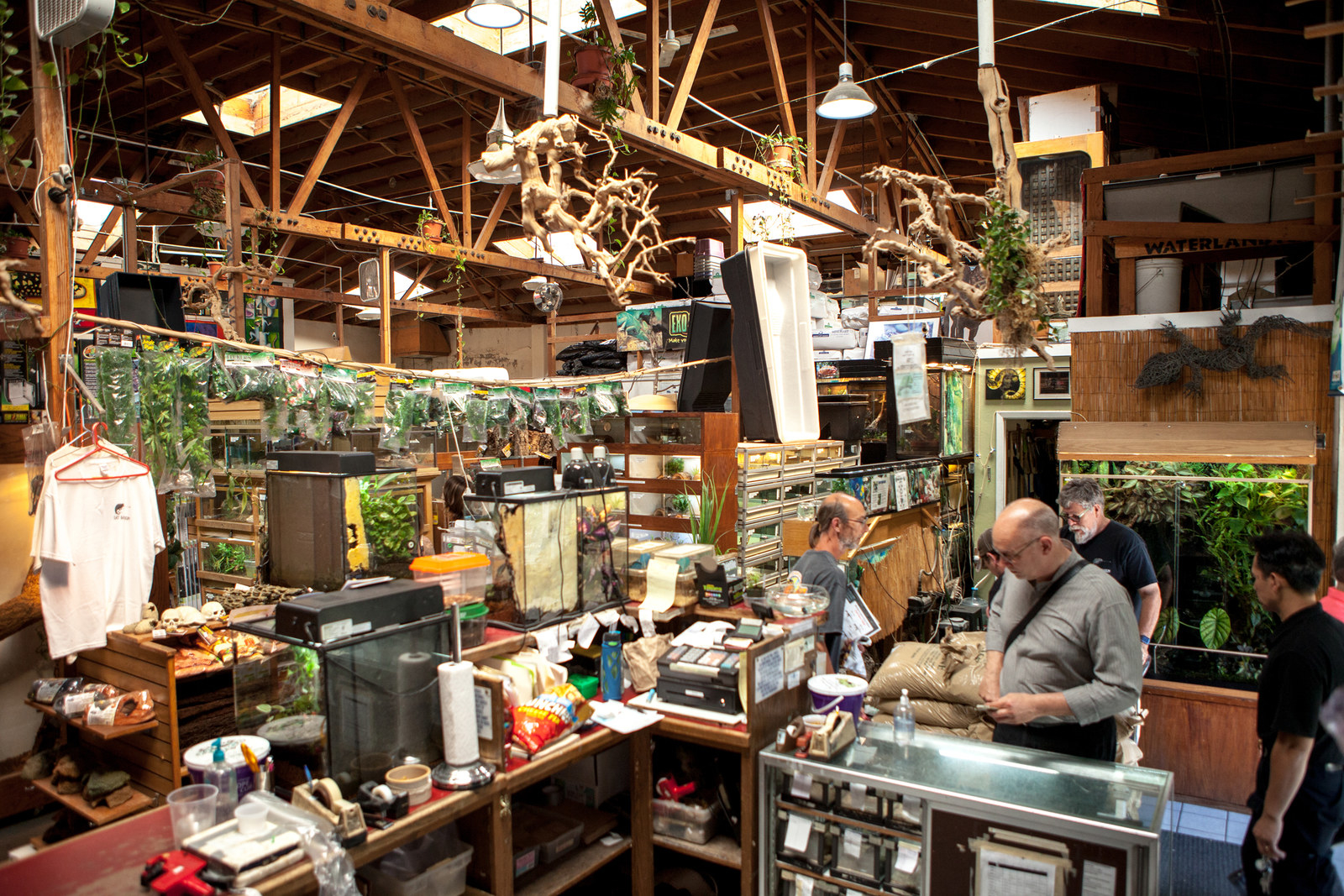
At Susan Tellem’s American Tortoise Rescue, Tank and another sulcata, Popcorn, ignored sweeping views of the Malibu hills as they chowed down on carrots and hay. Popcorn, or Poppy, is named after the popcorn and rice cakes he lived on before coming to the rescue, which also houses chickens, goats, and sheep. The boys have been kept separated by cinderblocks and chicken wire ever since a fight between the two landed Popcorn a bloody eye and Tellem and her husband had to cart the enormous animal off to the vet.
Tellem works hard to actively discourage breeding. She sends press releases to journalists who cover animal issues, encourages people who contact her for information to adopt instead of buying babies, and tells off others who email her looking for a female to breed. I asked her if she thinks there’s a place for ethical breeding — selling babies with the assurance that they go to good owners who are aware of the difficulties of sulcata ownership. “No, I don’t,” she responded. “With sulcatas, there’s just so many needing homes.”
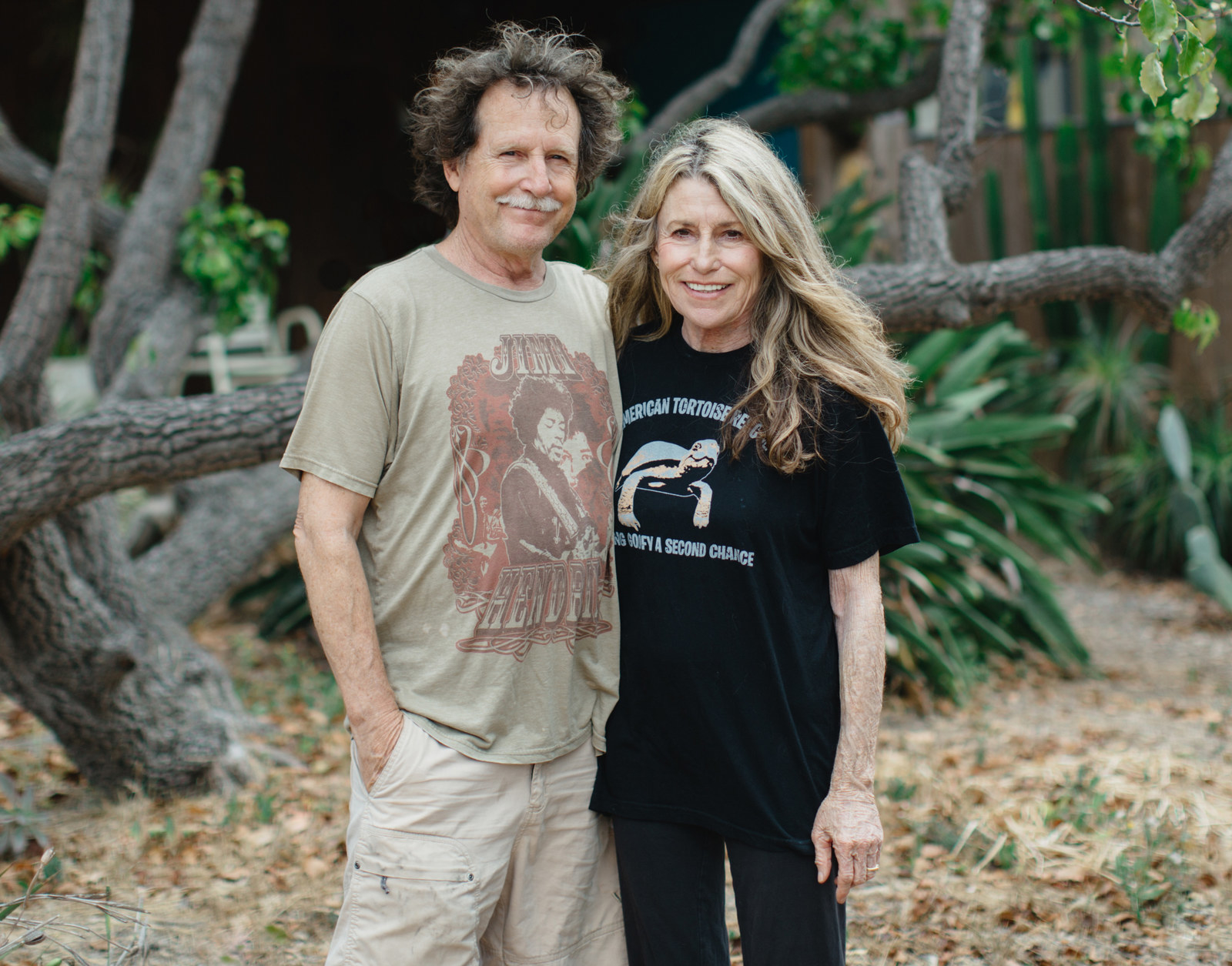
American Tortoise Rescue gets three to five emails a week from people trying to find new homes for their tortoises, but Tellem doesn’t have the room to take in new adult sulcatas. They operate more like a dating service, connecting homeless tortoises with potential adoptees. The rescue is very picky about whom they’ll place a sulcata with, and Tellem warns would-be adopters about having to put the animal into their will. “We’re trying to manage as many of these rehomings as possible, but sometimes it’s overwhelming,” she said.
Things got especially bad after the 2008 housing collapse. Tellem recalled a number of calls and emails from realtors trying to sell a house, only to find a giant tortoise in the backyard. She still gets those calls occasionally — not just about sulcatas, but about all kinds of abandoned turtles and tortoises.
The sulcata problem goes as far north as Northwest Tortoise in Washington state, which last year got eight sulcatas in two weeks, and as far east as Turtle Rescue of Long Island, which can’t take any more. The California Turtle and Tortoise Club took in at least 130 abandoned or surrendered sulcatas last year.

However, not everyone who rescues sulcatas takes such a hard line against breeding as Tellem. Al Wolf, director of the Sonoma County Reptile Rescue, has rescued dozens of sulcatas — a few years ago, he had 45 living on his 2-acre property in Sonoma County. He has since rehomed most of the males and is down to six sulcatas of his own.
Wolf thinks that between sulcatas being overbred and poached from the wild in Africa, extra giant tortoises is the lesser of two evils. “Do I think there are too many sulcatas? Hell yes. But we filled up the market to the top and now we’re on the downswing. Now people won’t even give you $500 for a female,” Wolf said, though it’s possible to find adult females online for $1,000. “It’s run its course. The die-hard people will still breed them and a lot of [tortoises] will die from people who don’t know how to take care of them,” he continued. “But we’ve successfully taken the value out.”
Maercks, at the East Bay Vivarium, believes that the market is nowhere near saturation, given the ease with which he sells his yearly batch of babies. When asked about the struggle rescues are having, he said he was surprised to hear about it. “Getting rid of excess males is a problem,” he said. “But there are still people out there who don’t want to get a baby and raise it up — they want a big tortoise walking around their yard now.”
In Maercks’s experience, it hasn’t been particularly tricky to find new homes for big sulcatas, though he acknowledged that a tortoise deformed by poor care would be harder to place. In fact, about six teachers keep a rotation going with him: They get a baby for the classroom, raise it up for a few years, and then trade it back to Maercks for a new baby.
“All these people trying to donate them aren’t coming to me.”

People forced to give up their tortoises are easy to vilify as irresponsible or careless. But for many owners, the decision is heartbreaking. Take Betty Olson, a 73-year-old in Bay Point, California, who got her sulcata, Dorry, when her son’s friend found him walking down the road in 2010. They tried to find his owners, but when that failed, Olson made room in her yard and her heart.
But after three years, Dorry repeatedly got sick with a bacterial infection. After the tortoise’s third bout with the illness, Olson realized Dorry must have been eating poop from local cats. Desperate to keep Dorry healthy, burdened by vet bills, and having no way to keep the cats out of her yard, Olson reached out to Gary and Ginger Wilfong, who run Bay Area Turtle and Tortoise Rescue, the biggest tortoise sanctuary in Northern California. Last September, after five years with Olson, Dorry moved to his new home.
“I got frantic on top of broke. ... I miss the heck out of him, but he’s happy,” Olson said. “Gary said I’m one of the only people who comes back and visits. He’s my baby! I told him, ‘If you do end up adopting him out, could you ask them if once in a while I could come peek at him?’ And he said, ‘Dorry is not for sale.’ He loves him too.” Dorry’s doghouse still sits in front of Olson’s house, with his name on it. She misses him terribly, but visits the sanctuary every chance she gets, to feed him treats and scrub his shell with a vegetable brush.

Down the coast from Dorry’s new home, in Costa Mesa, California, is Hodge Podge Lodge, another sanctuary run out of the backyard of Genevieve Rheaume, who restores boats, does catering, and sells skin care products for a living. “It helps pay for all this mess,” she said. Rheaume estimates she’s taken in around 500 or 600 fostered sulcatas over the last 12 years, along with other species of tortoises, cats, dogs, chameleons, and turtles.
When I visited in April, she had around a dozen tortoises wandering the yard or napping in a heated shed next to a big chameleon cage. Rheaume usually adopts out healthy tortoises through California Turtle and Tortoise Club and keeps the worst cases. Her resident sulcatas all bear the scars of injury, malnutrition, or neglect.
Frankie, Rheaume’s first sulcata, came to her 12 years ago with a pyramid-covered shell so soft she could push a thumb into it. Back then, he was 5 pounds; now he’s 130. “He’s like a goodwill ambassador,” Rheaume said about the friendly tortoise, as Frankie crawled under a ladder and then struggled to get out. “You can’t fit in there!” Rheaume sing-sang to him.
Angel, another sulcata, is missing half of one front leg and half of her other foot. Rheaume flipped her up on her hind legs so I could see the patch of her bottom shell that rotted away, probably from extended contact with water.
“The girls who owned her were like, ‘Oh, we just love our tortoise so much, but she’s so big we can’t keep her.’ And when I got her I’m like, ‘Wait a minute, she’s walking funny,’” Rheaume said. “This poor turtle’s been beat half to death.” But Angel is slowly healing. The bone in her leg, which was exposed when she came to Hodge Podge Lodge, has callused over; her bottom shell is slowly regrowing.
When young people give up their tortoises, Rheaume sometimes gives them a hard time about it, asking them why they’re dumping a pet. But older people whose kids don’t want the tortoises are hard for her. Often, the owners have had their tortoises for decades. What will happen when she gets too old to take care of her own crew?
“The ones I have, if they live 100 years it’s gonna be a miracle.”
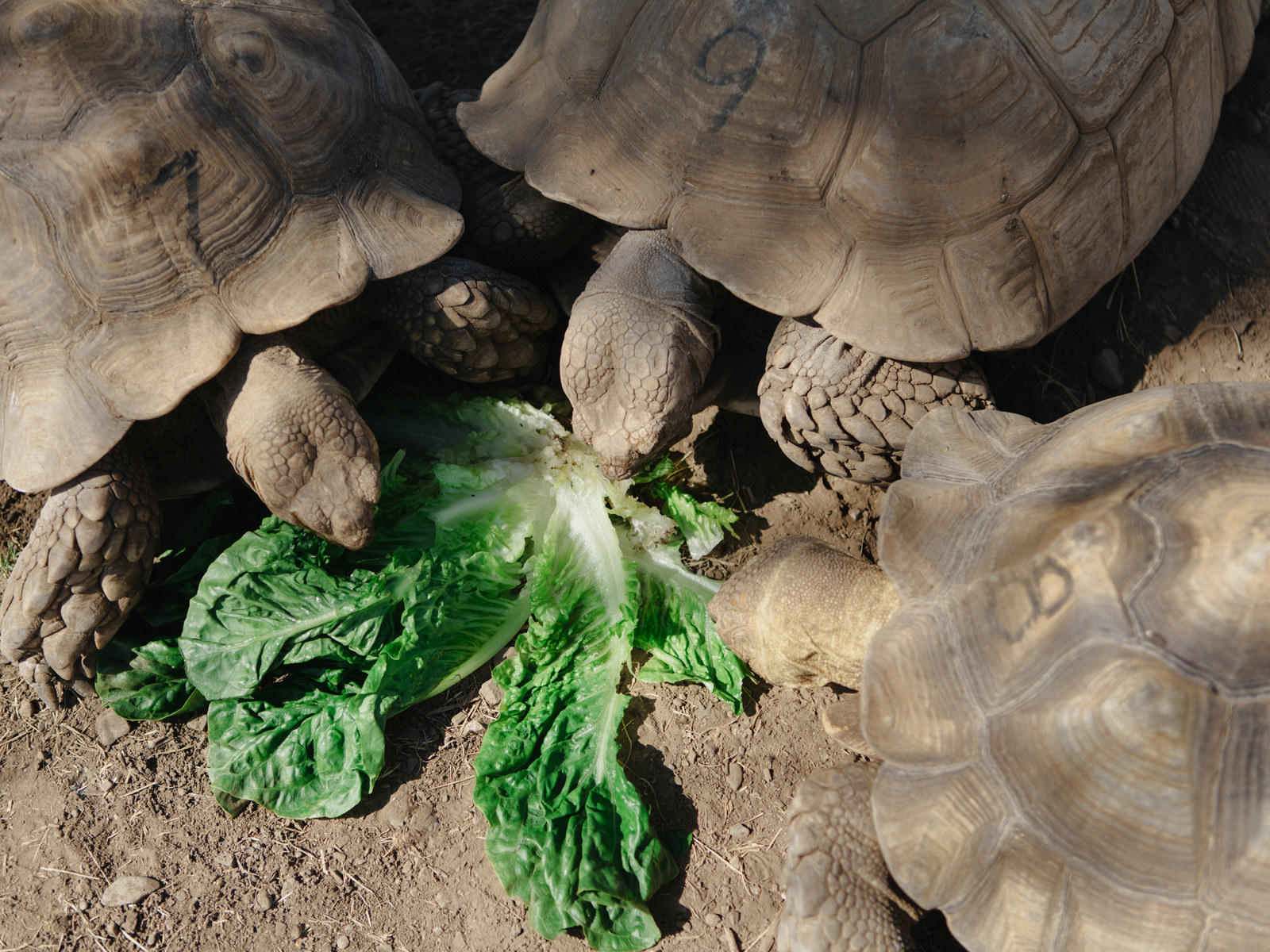
Seemingly on the opposite end of the spectrum from Rheaume’s rehabbing herd is New York City–based Henry, internet celebrity and star of the Instagram account TheNotortoiseBIG.
Henry lives in a Manhattan apartment with his owner, Amanda Green, and goes for several walks a week in Central Park, where he is carted in a baby stroller. During the day, he has a mostly free run of the apartment, including a heating pad to nap on when it’s chilly and a UVB and heating light over his food bowl. At night, he sleeps in a laundry hamper on its side, next to Green’s bed. Green calls him her “life partner.”
But Henry had a difficult early life, which shows both in the mild pyramiding on his shell and in the fact that, at 16 years old, he weighs only 17 pounds — a fraction of the 50 or 60 pounds a normal male sulcata would likely weigh at his age. Before Green adopted Henry three years ago from an overwhelmed owner, he spent most of his time in a Tupperware container. When he was allowed to roam, he ate “non-tortoise food” dropped by small kids in the house.
“People love him, but I’ve always tried to be open that I don’t think sulcatas are ideal pets for 98% of people,” Green said. “A lot of people see him on Instagram and are like, ‘Oh my god, I want one!’ But you can’t just get a pet like this. I’ve had to change a lot of my life to accommodate this creature.”
For one, Green has installed “tortoise guards” in her hallway and kitchen. Henry, like most sulcatas, loves to pace the fence line, three legs on the ground and one up on the baseboard, so his shell and front leg spikes were hell on the walls. When Green’s housecleaner comes, Henry has to chill in the tub for one of his regular baths; otherwise, he follows the cleaner around like a puppy. Green also keeps a baby gate across the living room. Otherwise, Henry can rearrange furniture or knock books off shelves. Even with the gate, he once got in and tipped over a 6-foot mirror, shattering it to bits. Miraculously, he was unharmed, but the episode still caused a heart-stopping moment for Green when she got home and saw glass everywhere.
According to Green, of the dozens of news stories that ran after she posted a Craigslist ad looking for a tortoise walker, including one in the New York Times, only a few briefly mentioned these caveats (including the one on this website), and the rest didn’t touch on them at all. “Maybe it’s a bit of a downer,” she suggested, when I asked her why she thought that was.
Despite the extra responsibility his care requires, Green loves Henry immensely and is even considering moving to a more appropriate climate, like LA, with outdoor space for him to roam. Having wanted a tortoise since she was a little girl, Green has now moved on to more expansive dreams, including opening her own animal sanctuary.
“I want a tortoise named Daphne and an alpaca named Valerie,” she said. “Dream big.”

While Green wants to give Henry a safe space to roam, other owners aren’t willing to make that kind of commitment to an unexpectedly demanding pet — so they dump them in the wild. “Sulcata are being found in the wild in Florida, in Texas, in Arizona, and also in the Mojave Desert in California,” Don Williams, chair of the adoption committee of the California Turtle and Tortoise Club, wrote in an email. Williams worries that sulcatas will either die out there or become pests, destroying already limited resources.
Luckily, just because an animal can live on its own as an adult doesn’t mean it can successfully breed and establish a stable population in the wild, according to Dave Burney, a paleoecologist who uses ex-pet sulcatas to help tame the weeds at the 17-acre Makauwahi Cave Reserve, which he runs with his wife. They specifically picked tortoises for the job because they believe the animals are unlikely to become invasive — especially since they haven’t done so, even after decades in the pet trade.

“If you look around the world on islands with tortoises, when people arrive they’re the first thing to go extinct,” Burney said. “They’re very slow, highly edible, and when they’re hatchlings they’re very vulnerable to feral cats and dogs — even chickens could kill the babies. There’s a lot that works against them.”
Burney’s reserve, located on the Hawaiian island Kauai, is kept as free of non-native plants as possible, to approximate the pre-human ecosystem in which giant flightless birds, including so-called tortoise-billed ducks, roamed the island. Burney believes the birds once filled the same ecological niche giant tortoises fill on the Galapagos and Aldabra islands, cropping weeds and keeping the competition lively between ground-level plants.
But the biggest tortoise species would have been prohibitively expensive to ship to Hawaii, and there was already a ready supply of local pet sulcatas with owners who would be happy to get rid of them. “A clear part of our mission is trying to provide a use for animals that have become a kind of surplus,” Burney said. “We’re giving them a good home, and in return they help us keep the weeds clipped.”
The 20 or so Makauwahi Cave tortoises range in size from “teenagers,” who are about 30 pounds, to Cal, a 200-pound male around 50 years old. Two graduate students from the University of Zurich did their master's projects on the tortoises and found that they were doing their jobs well, eating mostly non-native plants and the leaves and flowers of native plants that had fallen to the ground. The sulcatas are all carefully fenced in, and if one ventures off the reserve, the staff mobilizes to fetch it back.
For now, the sulcata population at the reserve is limited by how much fencing Burney and his wife can afford, and how much time and energy the two sixtysomethings can put toward the project. If they ever decide to expand, however, it won’t be tough to find the animals; according to Burney, they’ve already got a half dozen on the waiting list.
“People are constantly trying to give us more tortoises.”
Burney and his wife aren’t the only sulcata wardens in their sixties — or even older. A recurring theme among sulcata owners and rescuers I met was how close many of them are to aging out of the trade. Al Wolf, of the Sonoma County Reptile Rescue, told me that most of the people who come to him looking for a tortoise are over 50 and headed for retirement. And sanctuary living attracts an older crowd, too.

“It’s very unusual to see people in their twenties doing a successful rescue,” Wolf said. “Some young people do it, but they drop out, because they have to work for a living. I haven’t had a paycheck in 17 years.”
Since owning a home with a yard is a good foundation for successful sulcata ownership, it makes sense that an older demographic would end up with the animals, guaranteeing a perpetual motion machine of rehoming as life catches up to aging owners. But there’s something else going on too — a certain refusal to acknowledge mortality, or the idea that a pet outliving you will save on the pain of loss. The Sulcata Tortoises Facebook group describes the animals like this: “The best part is, they live. These tortoises can supposedly live up to 80 years, unlike dogs or cats. There will be no grievances at all.”
Bulley, the breeder at Tortuga Villa, is pushing 60, and his kids don’t want anything to do with the tortoises. As we sat on one of the low concrete walls that separated his dozen tortoise pens, I asked him what will happen when he dies, especially since he said he hasn’t made a will.
“If I knew I was going real quick, I’d probably start selling them off.” He paused for a few seconds. “I guess I don’t like thinking about that.” •
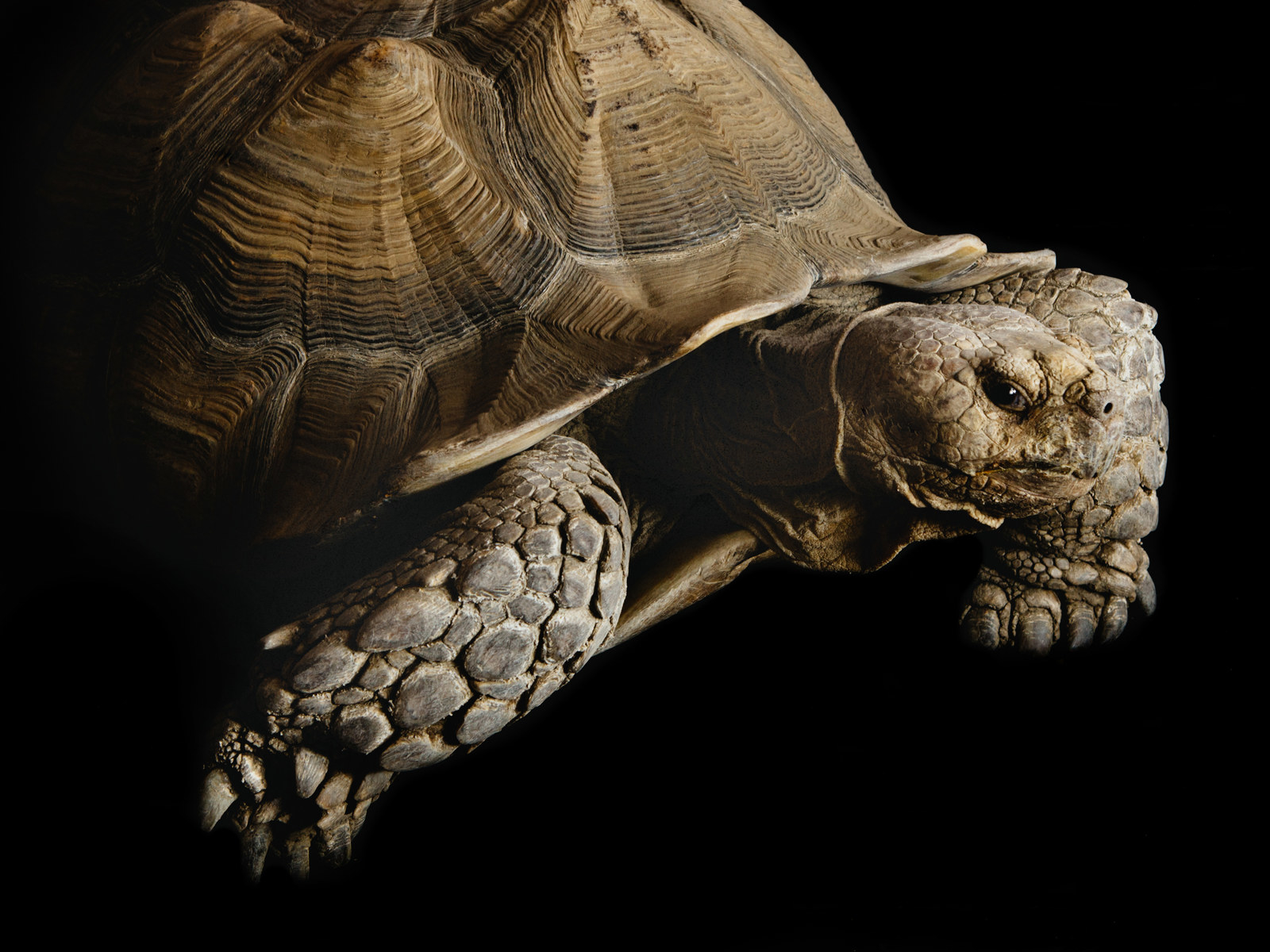
CORRECTION
A previous version of this story misstated Henry's age. We apologize to Henry.
